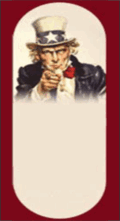Other Devvy Articles:
ACLU Demands LA County Remove Cross From Official Seal
SEN.
JOHN McCAIN: THE ULTIMATE "RHINESTONE HERO"
By: Devvy
August 26, 2004
NewsWithViews.com
Arizona Senator John McCain has been making big hay with the media lately regarding the anti-Kerry "Swift Boat" ads (search)calling for the White House to denounce them. McCain, never one to shy away from the camera, carries his own baggage from Viet Nam. This two part series was originally published in my old newsletter, The Power Educator, with permission from Ted Sampley of the U.S. Veteran Dispatch, July 1995. McCain has always had his own problems with Viet Nam veterans. The government's media apparatus has basically given him a free pass.
Part I
John McCain the second-term Republican senator from Arizona and former Navy pilot captured and held prisoner during the Vietnam War, is a fraud, collaborator, and danger to the security of the United States because he is being black-mailed by the communist Vietnamese. He is a phony--a "rhinestone hero."
While a prisoner of war, McCain was treated as a "special prisoner," with privileges including being given his own private and affectionate nurse.
McCain's treatment as a "special prisoner" is a contradiction to his much publicized image of a great war hero who was severely tortured and kept in solitary confinement for long periods of time because he refused to break during interrogation.
Ted Guy, a former Air Force Colonel held 5 1/2 years by the Vietnamese and McCain's senior ranking officer (SRO) in the POW camp, told the U.S. Veteran Dispatch he cannot remember the communists ever laying a hand on McCain.
Other sources have told the U.S. Veteran Dispatch that the Vietnamese are holding as much as fifty hours of film footage secretly taken of McCain during the time his KGB-trained handlers had him isolated from other U.S. prisoners of war.
Some of the film, according to the sources, is of McCain receiving special privileges during the time he claims he was being tortured and held in long-term solitary confinement.
The sources say interrogators have candid camera footage of McCain with the nurse, who allegedly supplied him with more than just medical attention during those lonely days and nights in so-called solitary confinement.
In June 1992, Trung Hieu, a film director from the Vietnamese Ministry of Culture and former North Vietnamese Army photographer, told the U.S. Veteran Dispatch that Hanoi does have considerable film of POW McCain and some of it involves a Vietnamese woman.
Trung, who worked during the war as an official photographer in North Vietnam's POW camps, was in the United States seeking political asylum when he told the U.S. Veterans Dispatch about the film.
Trung also said that during the war he photographed a nearly intact B-52 bomber, which was shot down at the edge of an air field near Hanoi in December 1972. He said the North Vietnamese traded the B-52 and some of its surviving crew members to the Soviets for three MIG-23 jet interceptors. Trung said the Soviets wanted to interrogate the crew about U.S. electronic warfare.
Trung said he took movie film of an American F-111 fighter bomber also shot down in 1972. He said the F-111 capsule, along with the surviving crew, was sent to China. The crew, according to Trung, was later returned to Hanoi.
McCain, who was a member of the 1992 Senate Select Committee on POW/MIA Affairs, argued emotionally during the hearings that "none of the returned U.S. prisoners of war released by Vietnam were ever interrogated by the Soviets."
Trung has said Hanoi has a large, secret vault containing shelves loaded with POW/MIA related film, which it has never allowed the U.S. government to view.
Gene Brown, who was employed by the Defense Intelligence Agency (DIA) for a period of time in 1992 and 1993, told the U.S. Veteran Dispatch that, while in Hanoi, he had been inside a vault which contained wall-to-wall film and that there appeared to be approximately 50 hours of film about McCain.
Brown, who was in Hanoi secretly working for the DIA under the code name "Druid Smoke" succeeded in smuggling nearly 4,500 photographs out of Hanoi by buying them from Communist officials with money supplied by the DIA. The photos, most of which had never been seen by the U.S. government, were taken during the Vietnam War and depicted, Americans killed in the war and the wreckage of many U.S. aircraft.
To avoid embarrassing the communists, USG officials declared the release of Brown's black market photographs "important progress" and "unprecedented cooperation" toward resolving the POW/MIA issue and publicly thanked the Vietnamese for their cooperation.
Garnett Bell, a 30 year employee of DOD and former chief of the U.S. office for POW/MIA Affairs in Hanoi, told the U.S. Veteran Dispatch that he had actually seen some film footage of McCain taken by the Vietnamese when McCain did not know he was being filmed.
Last month the United Press International (UPI) quoted the Cambodian Khmer Rouge accusing McCain of being a "Vietnamese Agent."
"Who is John McCain?" the rebel group asked rhetorically in a radio broad-case monitored in Bangkok. "He is Vietnamese. He has a Vietnamese wife and Vietnamese children. He is an American by nationality, but he is a Vietnamese agent..."
McCain the collaborator
From the first days of McCain's captivity, he seriously violated the Military Code of Conduct, which outlines the basic responsibilities and obligations of members of the Armed Forces of the United States who have been captured by the enemy.
According to documentation obtained by the U.S. Veteran Dispatch, not only did POW McCain promise to give the communists "military information" in exchange for special hospital care not ordinarily available to U.S. prisoners, but he also made numerous anti-war radio broadcasts.
Article V of the Code of Conduct is very specific in declaring that U.S. military personnel are required to avoid answering questions to the utmost of their ability and to make no oral or written statements disloyal to the United States and its allies or harmful to their cause. Any violation of this code is considered collaborating with the enemy.
The following is McCain's own admission of collaboration in an article he wrote, printed May 14, 1973 in U.S. News and World Report:
"I think it was on the fourth day [after being shot down] that two guards came in, instead of one. One of them pulled back the blanket to show the other guard my injury. I looked at my knee. It was about the size, shape and color of a football. I remembered that when I was a flying instructor a fellow had ejected from his plane and broken his thigh. He had gone into shock, the blood had pooled in his leg, and he died, which came as quite a surprise to us - a man dying of a broken leg. Then I realized that a very similar thing was happening to me.
"When I saw it, I said to the guard, `O.K., get the officer.'"
"An officer came in after a few minutes. It was the man that we came to know very well as "The Bug." He was a psychotic torturer, one of the worst fiends that we had to deal with. I said, `O.K., I'll give you military information if you will take me to the hospital.'"
The Admiral's son gets "special treatment"
McCain claims it was only a coincidence that, about the same time he was begging to be taken to a hospital, the Vietnamese learned his father was Admiral John S. McCain, Jr., commander of all U.S. forces in Europe and soon-to-be commander of all U.S. forces in the Pacific, including Vietnam.
McCain does concede he survived because the Vietnamese learned who his father was, rushing him to a hospital where his wounds were eagerly treated.
The former POW admitted in the U.S. News and World Report article that the Vietnamese usually left other U.S. prisoners with similar wounds to die, not wishing to waste medication on them. McCain pointed out "there were hardly any amputees among the prisoners who came back because the North Vietnamese just would not give medical treatment to someone who was badly injured. They weren't going to waste their time."
McCain has failed to mention what he has confided to another U.S. prisoner that since the Vietnamese felt they had in their hands such a "special prisoner" and propaganda bonanza, a Soviet surgeon was called in to treat him.
The communists figured that because POW McCain's father was of such high military rank, McCain was of royalty or the governing circle. They bragged that they had captured "the crown prince."
His communist handlers believed McCain, because he came from a "royal-family", would, when finally released, return to the United States to some important U.S. military or government job. Communist Interrogators and psychological warfare experts drooled at the thought.
McCain's handlers were very much aware that he would be under great psychological pressure not to do or say anything that would tarnish the name of his famous military family.
In fact, the communists considered that to be the key to eventually breaking and then "turning" their "special" prisoner, using blackmail if necessary.
According to U.S. government documents, within a week of POW McCain being transferred to the Gai Lam military hospital, the Hanoi press began quoting him giving specific military information.
One report dated Nov. 9, 1967 read, "The question of the correspondent, McCain answered: "My assignment in to the Oriskany, I told myself, was due to serious losses of pilots, which were sustained by this aircraft carrier (due to raids on the North Vietnamese Territory (VNA), and which necessitated replacements. From 10 to 12 pilots were transferred like me from the forest to the Oriskany. Before I was shot down, we had made several sorties. All together, I made about 23 flights over North Vietnam."
In that article, McCain was further quoted describing the number of aircraft in his flight, information about rescue ships, and the order of which his attack was supposed to take place.
Six weeks after McCain was shot down, he was taken from the hospital and delivered to Room No. 11 of "The Plantation" and into the hands of two other POWs, who helped further nurse him along until he was eventually able to walk by himself.
Afterwards, his handlers isolated "special prisoner", McCain from other American prisoners and made him the target of intense psychological programs.
Part II - McCain continuously violates the code of conduct
� 2004 Devvy Kidd - All Rights Reserved
Devvy Kidd authored the booklets, Why A Bankrupt America and Blind Loyalty, which sold close to 2,000,000 copies. Has been a guest more than 1600 times on radio shows, ran for Congress twice and is a highly sought after public speaker. Devvy is a contributing writer for www.NewsWithViews.com Devvy's web site is: www.devvy.com; is sponsored by El Dorado Gold; e-mail is: devvyk@earthlink.net
From the first days of McCain's captivity, he seriously violated the Military
Code of Conduct, which outlines the basic responsibilitiese and obligations
of members of the Armed Forces of the United States who have been captured
by the enemy.









